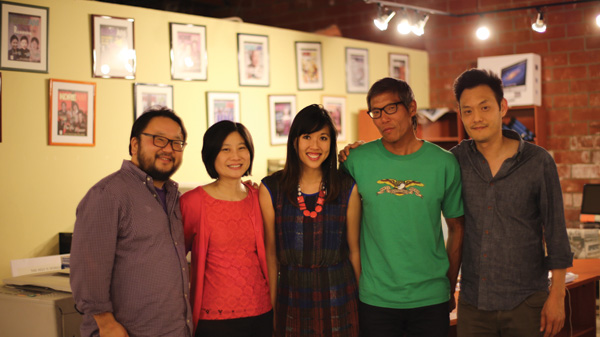Pictured above: From left to right—Jimmy Lee, Julie Ha, Michelle Woo, John Lee and Ken Lee.
Twenty-five years ago, KoreAm Journal started out as a newsmagazine published on newsprint. “Get Involved!” encouraged the headline on the cover story for the very first issue published April 1990. Featuring news briefs, a profile of Cerritos City Council candidate Charles Kim, restaurant reviews, personal commentary and even a mini-guide to the Korean language, KoreAm boldly announced its arrival in the alternative media space.
In the last quarter-century, the publication, which would eventually evolve into a glossy magazine, has kept a pulse on the issues and people forming the fabric of the Korean American community, as it continues to strive to fulfill the vision outlined by founding publisher Jung Shig Ryu in his inaugural note to readers: “We at KoreAm Journal are dedicating ourselves to cultivating an awareness of the Korean heritage, and informing people of the events happening not only in their homeland, but also in their communities.”
To honor KoreAm’s 25th anniversary, we invited former editors who steered the magazine between 1991 and 2014 to reflect on the milestones over the years. Their recollections touched on the humorous to the heartfelt. We couldn’t print the entirety of the conversation, recorded at KoreAm’s office in Gardena, Calif., due to space and some off-the-record moments, but below is a transcript of the dialogue’s highlights.
You can also watch the first half of the discussion in the video here:
How Each First Came Across KoreAm
Jimmy Lee: When I was working at KYCC (Los Angeles’ Koreatown Youth and Community Center). We would get the magazine at the office.
Ken Lee: My mom was very active in the Korean community, so she was subscribing to it and I would just see it around the house. This was in the mid-’90s. At the time, it was still a newspaper.
Julie Ha: I actually started receiving KoreAm in my mailbox at the UCLA dormitory. I was like, why am I getting this all of a sudden? But it was free. I do remember being surprised I saw it in my mailbox and thinking, “Oh, this is sort of cool.”
Michelle Woo: I don’t know how I first heard about it, but I first heard about the [staff writer] job on journalismjobs.com. I don’t have a great story behind it, but I was living in Phoenix at the time. I’m not Korean—I’m Chinese—but my last name is Woo—W-o-o—so it could be either [Chinese or Korean], so I think that’s what got me the interview.
 A March 5, 1991 letter sent by KoreAm publisher James Ryu to potential subscribers.
A March 5, 1991 letter sent by KoreAm publisher James Ryu to potential subscribers.
Most Memorable Cover Issues or Stories
Jimmy: The 10-year anniversary of the L.A. riots. Putting that one together was pretty daunting. I think we tried to tackle more than we probably should have. I think for the most part we succeeded, but we really tried to take a look at the riots in a historically comprehensive sort of way. I think that the end result turned out to be very satisfying.
The riots were a very sort of defining moment for KoreAm, especially for the community, but specifically for KoreAm. It was right there at its infancy, we sort of kind of grew up with it.
Julie: In a way, the [L.A. riots] sort of underscored the whole purpose of KoreAm: to have a voice for Korean Americans in the media. A lot of Korean immigrants especially felt like they had no voice in the mainstream media, and that they were being totally misrepresented, underrepresented, as gun-toting Koreans guarding their stores, at any cost … and not really being humanized. There weren’t all these bilingual reporters at mainstream newspapers and TV stations, so I think that’s when a lot of Korean Americans felt like, “Wow, we have no voice.”
John Lee: [In late 1993, we ran] this photo essay by a Korean American photographer from New York who came to Los Angeles after the riots. He embarked on this mission to meet and photograph Korean merchants in the South Los Angeles area. I met him and got to go out on some of his shoots. He had a really good way of working with the merchants. He seemed to understand their lives and had a real comfortable rapport with them. Some of the images he got were really telling about how kind of mundane life is in the Korean liquor store in South Los Angeles, but they had a good way of giving insight into the motivation of people both behind the counter and in front of the counter. We ran this story in KoreAm Journal around the same time.
He eventually ended up working for the New York Times. Before that, we worked on a similar photo essay for the L.A. Times Sunday Magazine. He took photographs; I did a write-up for them.
 “The Hard Life,” a photo essay by Chang W. Lee featured in the Dec. 1993 issue of KoreAm.
“The Hard Life,” a photo essay by Chang W. Lee featured in the Dec. 1993 issue of KoreAm.
Ken: For me, it would be the [Dec. 1998] cover story we did on the North Korea famine. At the time, it felt like it wasn’t really something that was being discussed in the Korean American community, and at the time in the global community, it was known as the “silent famine” because it was largely being ignored. So, what I discovered was that a lot of first-generation Koreans still had very much a Cold War mentality in which they didn’t—they refused—to see past the politics and into the human suffering that was going on there. On that note, there was so much information that was being blocked, so it’s kind of understandable [that] it wasn’t at the forefront of people’s minds at the time.
At the time, it was just me and [KoreAm publisher] James [Ryu] essentially running the magazine. For two guys in a warehouse to make a cover story out of very little means—it was very satisfying to put that up and get a lot of congratulatory letters from people in the community.
 The Dec. 1998 North Korea famine issue
The Dec. 1998 North Korea famine issue
Jimmy: That was the infamous phone call issue, right?
Ken: The story, it’s not too tired? I’m just going to pretend you guys aren’t here (motioning to the group), because they’ve heard it over and over. So, as I was saying, it was just me and James working in a warehouse, trying to put this important global issue together. I had managed to get a phone number of human rights workers who were in North Korea. One was a Canadian and the other was an American, and they were working in Pyongyang doing food distribution. I was able to just call them from here in Gardena to Pyongyang, North Korea, and just conduct, like, a two- or three-hour interview.
It felt like I was calling the moon from planet Earth in terms of having that accessibility. So I kind of forgot about it and then about two months later, we were in the office and James is like, “Keeeennnnnn!!!!” He was looking at the phone bill. I wasn’t surprised if it was something like, two dollars per minute. It was pretty bad, it was in the thousands. This was before Skype.
 May 2007 Virginia Tech issue
May 2007 Virginia Tech issue
Michelle: For me, this issue here stands out (holds up copy of magazine). So this is May 2007. It’s all about Virginia Tech. The cover is, “Our Country, Our Tragedy,” on the Virginia Tech massacre. It was about a week before we were going to print. We had our cover story all laid out on Sonya Thomas, a competitive eater. She’s holding two hot dogs, and it was just this fun, lighthearted cover. And then, I think it was less than a week before we were going to go to print, there was this tragedy at Virginia Tech.
I was a staff writer at the time, and Corina Knoll was the editor. We had this meeting. We just decided to scratch all of our coverage and go full force with this. We wrote about the community response in Virginia, the Korean American community’s responses here, and how the Korean community felt this tragedy so deeply. Seung-hui Cho … I don’t think anyone could ever forget that name or that photograph.
I remember Margaret Cho in her standup was saying that when we heard that the shooter was Asian, everyone was like … ‘Please don’t let him be Korean.’ And I guess her whole joke was, not only was he Korean, but his last name was Cho. After covering all this, I think the community really appreciated that standpoint.
Julie: I remember people being worried that there might be anti-Asian hate crimes. That was a big fear and I remember being really happy about this issue because it was very proactively getting on top of that current issue and covering it from a point of view that I hadn’t seen in the mainstream. Even Seung-hui Cho was called “Cho Seunghui” for the longest time— last name first, and then his first name, which made him seem even more foreign versus American.
Jimmy: The one issue I’m proud of is our 2002 World Cup story. That was the year South Korea co-hosted with Japan and there was all this excitement within the Korean American community. What sucked for us here on the West Coast was that a lot of games were at 4 o’clock in the morning. There were all these big events going on, and so we were there covering it, and it got to be quite the, you know, hazard to our sleeping health (laughs). But to see the Korean American community rally and get excited [over an event that] brought people all over together was a lot of fun.
On Memorable Moments as Editor
Jimmy: Oh, there were plenty of bizarre moments. Once I got here, we were able to devote a little more [staff] resources. We actually had a photographer. We got to do a little bit more and, I like to say, we sort of experimented. We went to a Korean bathhouse and took photos.
Ken: In the name of journalism, right?
Jimmy: Exactly. Strictly in the name of journalism. I got to see my co-workers naked (laughs). We won’t tell you who those people were.
Julie: Striking resemblance to Jimmy and [publisher] James [Ryu].
Ken: I’ve got one. This guy who used to help out at the magazine, he was so obsessed with ear pickers to clean ear wax out of your ear. I said, “I totally get it, but if you’re gonna do this story, it’s gotta be funny. You can’t do a very hard-hitting, serious story about ear picks.” And he got really upset and he did the story after I left.
Jimmy: Yeah, I read it. I never saw his original story. It became more of a fun kind of story about the different kinds of ear-pickers. [Koreans] are pretty innovative when it comes to some personal hygiene products so, you know, we had some fun with it, I guess.
In Part 2 of the roundtable discussion, former KoreAm editors talk about how they formed fun and creative columns, memorable feedback from readers, KoreAm‘s growing digital presence and what they learned most about the Korean American community during their tenures. Stay tuned!
___
This article was published in the April/May 2015 issue of KoreAm. Subscribe today! To purchase a single issue copy of the April/May issue, click the “Buy Now” button below. (U.S. customers only. Expect delivery in 5-7 business days).











